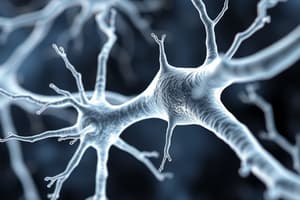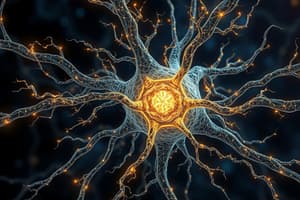Podcast
Questions and Answers
What type of amnesia did H.M. experience after his surgery?
What type of amnesia did H.M. experience after his surgery?
- Only anterograde amnesia
- Both retrograde and anterograde amnesia (correct)
- Only retrograde amnesia
- No amnesia at all
Which of the following abilities was preserved in H.M. after his surgery?
Which of the following abilities was preserved in H.M. after his surgery?
- Ability to interact only with familiar faces
- Ability to form new episodic memories
- Ability to learn new motor skills (correct)
- Ability to remember all past events
What typically characterizes the loss of memories in retrograde amnesia?
What typically characterizes the loss of memories in retrograde amnesia?
- Loss of memories for only procedural skills
- Loss of older memories only
- More recent memories are lost while older ones are often spared (correct)
- Complete loss of all memories regardless of time
What is the purpose of structural neuroimaging techniques like MRI?
What is the purpose of structural neuroimaging techniques like MRI?
Which regions of the brain were primarily affected by H.M.'s surgery?
Which regions of the brain were primarily affected by H.M.'s surgery?
What does structural neuroimaging primarily measure?
What does structural neuroimaging primarily measure?
Which of the following best describes the function of neurons?
Which of the following best describes the function of neurons?
What is a key difference between recognition and recall in memory testing?
What is a key difference between recognition and recall in memory testing?
How is functional neuroimaging different from structural neuroimaging?
How is functional neuroimaging different from structural neuroimaging?
What correlation was found in Maguire's study on London taxi drivers?
What correlation was found in Maguire's study on London taxi drivers?
What is the primary function of dendrites in a neuron?
What is the primary function of dendrites in a neuron?
Which part of the neuron is responsible for sending signals to other neurons?
Which part of the neuron is responsible for sending signals to other neurons?
What is required to trigger an action potential in a neuron?
What is required to trigger an action potential in a neuron?
What is the role of the myelin sheath in neuronal communication?
What is the role of the myelin sheath in neuronal communication?
Which statement best describes synaptic transmission?
Which statement best describes synaptic transmission?
How does the flow of information in a neural network typically progress?
How does the flow of information in a neural network typically progress?
What does functional specialization in brain organization refer to?
What does functional specialization in brain organization refer to?
The patient H.M. is often cited in neuroscience for which reason?
The patient H.M. is often cited in neuroscience for which reason?
What is the primary function of a neuron's receptive field?
What is the primary function of a neuron's receptive field?
How does long-term potentiation (LTP) primarily strengthen synaptic connections?
How does long-term potentiation (LTP) primarily strengthen synaptic connections?
What effect does long-term depression (LTD) have on synaptic transmission?
What effect does long-term depression (LTD) have on synaptic transmission?
What is an example of a process involved in Hebbian learning?
What is an example of a process involved in Hebbian learning?
What role do cell assemblies play in memory?
What role do cell assemblies play in memory?
Which of the following best describes the concept of specificity in long-term potentiation?
Which of the following best describes the concept of specificity in long-term potentiation?
What is a characteristic of neurons in the primary visual cortex (V1)?
What is a characteristic of neurons in the primary visual cortex (V1)?
What phenomenon occurs when familiar features are not combined correctly in memory?
What phenomenon occurs when familiar features are not combined correctly in memory?
What defines a distributed representation in relation to visual objects?
What defines a distributed representation in relation to visual objects?
How do neurons in area V4 behave differently from those in area V1?
How do neurons in area V4 behave differently from those in area V1?
Flashcards
Longitudinal neuroimaging
Longitudinal neuroimaging
A technique that uses repeated scans to track changes in brain structure over time.
Posterior hippocampus
Posterior hippocampus
A brain region involved in spatial memory and navigation.
Functional neuroimaging
Functional neuroimaging
A technique that measures brain activity in real-time by detecting changes in blood flow.
Recognition memory
Recognition memory
Signup and view all the flashcards
Recall memory
Recall memory
Signup and view all the flashcards
Henry Molaison (H.M.)
Henry Molaison (H.M.)
Signup and view all the flashcards
Anterograde Amnesia
Anterograde Amnesia
Signup and view all the flashcards
Retrograde Amnesia
Retrograde Amnesia
Signup and view all the flashcards
Medial Temporal Lobes
Medial Temporal Lobes
Signup and view all the flashcards
Structural Neuroimaging
Structural Neuroimaging
Signup and view all the flashcards
Neuron
Neuron
Signup and view all the flashcards
Dendrite
Dendrite
Signup and view all the flashcards
Action Potential
Action Potential
Signup and view all the flashcards
Synapse
Synapse
Signup and view all the flashcards
Neural Network
Neural Network
Signup and view all the flashcards
Functional Specialization
Functional Specialization
Signup and view all the flashcards
Dissociation
Dissociation
Signup and view all the flashcards
Patient H.M.
Patient H.M.
Signup and view all the flashcards
Uncanny Valley
Uncanny Valley
Signup and view all the flashcards
Receptive Field
Receptive Field
Signup and view all the flashcards
Distributed Representations
Distributed Representations
Signup and view all the flashcards
Hebbian Learning
Hebbian Learning
Signup and view all the flashcards
Cell Assembly
Cell Assembly
Signup and view all the flashcards
Pattern Completion
Pattern Completion
Signup and view all the flashcards
Synaptic Plasticity
Synaptic Plasticity
Signup and view all the flashcards
Long-Term Potentiation (LTP)
Long-Term Potentiation (LTP)
Signup and view all the flashcards
Specificity (LTP)
Specificity (LTP)
Signup and view all the flashcards
Associativity (LTP)
Associativity (LTP)
Signup and view all the flashcards
Study Notes
Neuroscience
- Neurons: Specialized cells in the nervous system for information processing, forming the basis of mental representations. Information is passed electrically and chemically. Function depends on connectivity patterns.
- Dendrites: Collect signals from other neurons.
- Cell body: Integrates signals.
- Axon: Sends signals to other neurons.
- Myelin sheath: Speeds signal transmission.
- Axon terminals: Synaptic information.
- Synapse: Point where signals pass between neurons. Input signals are gathered at dendritic connections. Inputs can be excitatory or inhibitory.
- Action potential: An electrical signal triggered by enough excitatory input. It's an "all-or-none" (binary) response. Synaptic transmission (using neurotransmitters) transmits the signal to other neurons' dendrites.
- Neural networks: Networks of interconnected neurons represent information processing.
- Excitatory Input: Received from one presynaptic neuron, not enough to trigger an action potential in the postsynaptic neuron.
- Lots of Excitatory Input: Received from many presynaptic neurons, triggers an action potential. The signal is passed on.
- Neural Network Representation: A network diagram depicts networks by using a circle for each neuron.
- Brain Organization: Mapping brain organization helps theories of learning and memory.
- Functional Specialization: Different parts of the brain have dedicated functions.
- Dissociations in Brain Function: Evidence for multiple memory systems that operate simultaneously.
- Patient H.M.: Had surgery to reduce epilepsy. Suffered retrograde and anterograde amnesia. Had impairments in declarative memory (words, drawings, etc.)
- Structural Neuroimaging: Snapshot of brain's anatomical structure. Methods include MRI and DTI. MRI uses cross-sectional or longitudinal comparisons to study brain structure changes.
- Functional Neuroimaging: Records real-time brain activity changes (e.g., blood flow).
Neuroscience Part 2
-
Testing Memory:
-
Recognition: Identifying previously experienced events.
-
Recall: Retrieving details about an experience given a cue.
-
Visual Memory: New faces involve linking low-level visual features.
-
Facial Features: A combination of features creates a novel representation in memory.
-
Familiar Features: Recognition occurs when familiar features are combined correctly.
-
Uncanny Valley: Recognition problems occur when familiar features are miscombined.
-
Receptive Fields: The stimulus range that activates single neurons. Visual cortex neurons respond to specific line orientations.
-
Distributed Representations: Visual processing involves increasing complex features as the visual system processes information.
-
V1: Responds to line segments.
-
V4: Responds to complex shapes.
Hebbian Learning and Pattern Completion
- Donald Hebb: Theory of associative learning and memory, The Organization of Behavior.
- Mental Representations: Constructed through synaptic plasticity in neural networks.
- Hebbian Learning: Learning through strengthening connections between neurons that fire together.
- Cell Assembly: Group of interconnected neurons operating as a functional unit, allowing pattern completion.
- Synaptic Plasticity: Modification of synaptic transmission strength.
- Long-term Potentiation (LTP): Synaptic transmission becomes more effective due to recent activity. Requires repeated stimulation.
- Long-term Depression (LTD): Synaptic transmission weakens due to recent activity or lack of stimulation.
- Specificity: LTP effect specific to presynaptic neurons.
- Associativity: LTP also occurs with simultaneous, weaker activity.
- Long-Term Depression: Synaptic transmission weaker due to recent activity mismatches.
Studying That Suits You
Use AI to generate personalized quizzes and flashcards to suit your learning preferences.




